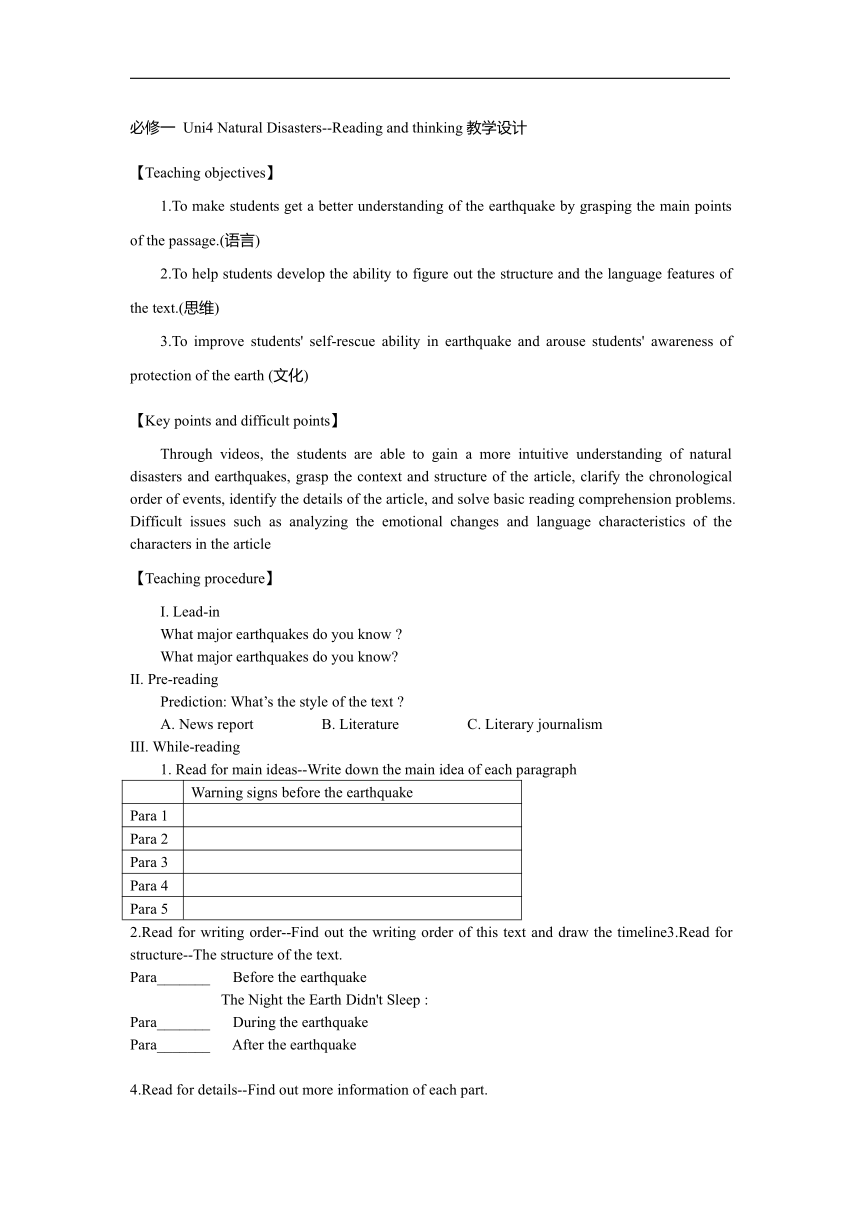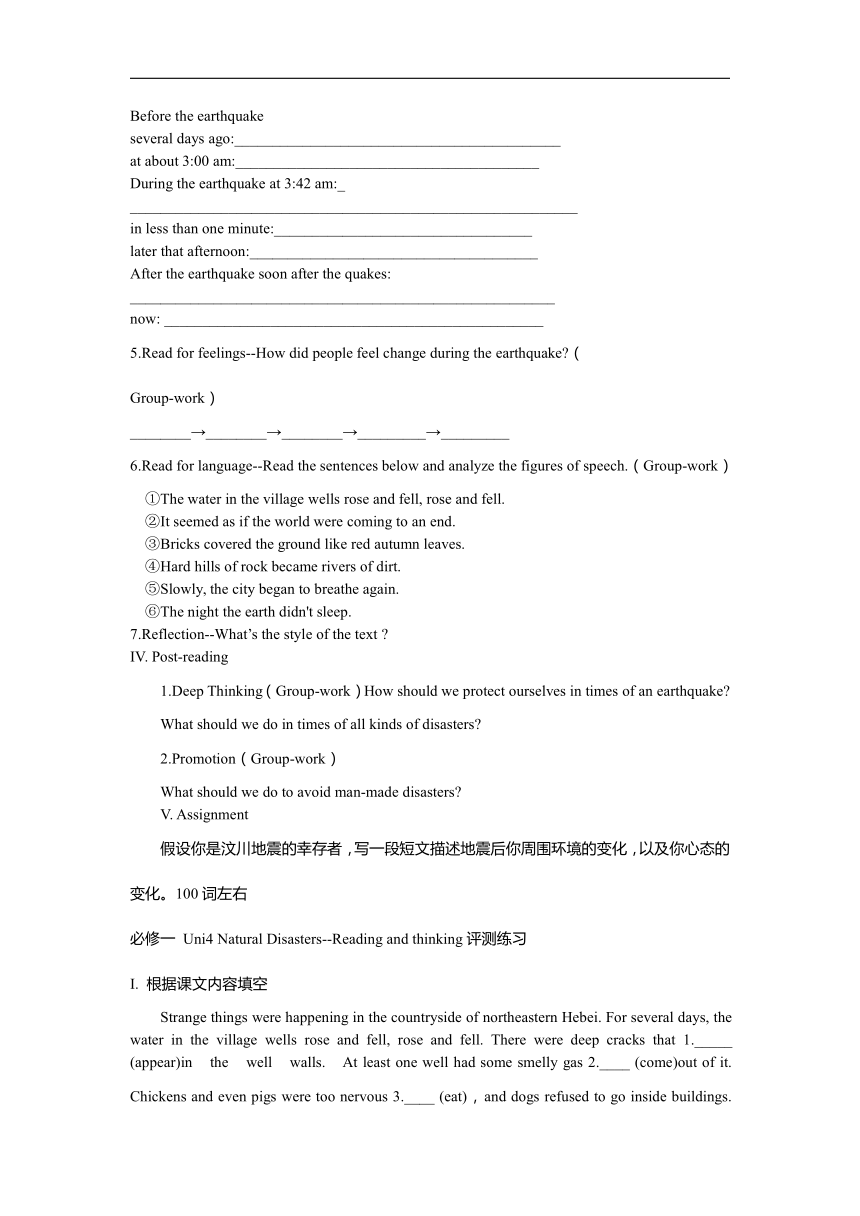人教版(2019)必修 第一册Unit 4 Natural disasters Reading and thinking 教学设计
文档属性
| 名称 | 人教版(2019)必修 第一册Unit 4 Natural disasters Reading and thinking 教学设计 |  | |
| 格式 | docx | ||
| 文件大小 | 18.4KB | ||
| 资源类型 | 教案 | ||
| 版本资源 | 人教版(2019) | ||
| 科目 | 英语 | ||
| 更新时间 | 2024-03-20 21:27:25 | ||
图片预览


文档简介
必修一 Uni4 Natural Disasters--Reading and thinking教学设计
【Teaching objectives】
1.To make students get a better understanding of the earthquake by grasping the main points of the passage.(语言)
2.To help students develop the ability to figure out the structure and the language features of the text.(思维)
3.To improve students' self-rescue ability in earthquake and arouse students' awareness of protection of the earth (文化)
【Key points and difficult points】
Through videos, the students are able to gain a more intuitive understanding of natural disasters and earthquakes, grasp the context and structure of the article, clarify the chronological order of events, identify the details of the article, and solve basic reading comprehension problems. Difficult issues such as analyzing the emotional changes and language characteristics of the characters in the article
【Teaching procedure】
I. Lead-in
What major earthquakes do you know
What major earthquakes do you know
II. Pre-reading
Prediction: What’s the style of the text
A. News report B. Literature C. Literary journalism
III. While-reading
1. Read for main ideas--Write down the main idea of each paragraph
Warning signs before the earthquake
Para 1
Para 2
Para 3
Para 4
Para 5
2.Read for writing order--Find out the writing order of this text and draw the timeline3.Read for structure--The structure of the text.
Para_______ Before the earthquake
The Night the Earth Didn't Sleep :
Para_______ During the earthquake
Para_______ After the earthquake
4.Read for details--Find out more information of each part.
Before the earthquake
several days ago:___________________________________________
at about 3:00 am:________________________________________
During the earthquake at 3:42 am:_
___________________________________________________________
in less than one minute:__________________________________
later that afternoon:______________________________________
After the earthquake soon after the quakes:
________________________________________________________
now: __________________________________________________
5.Read for feelings--How did people feel change during the earthquake (
Group-work)
________→________→________→_________→_________
6.Read for language--Read the sentences below and analyze the figures of speech.(Group-work)
①The water in the village wells rose and fell, rose and fell.
②It seemed as if the world were coming to an end.
③Bricks covered the ground like red autumn leaves.
④Hard hills of rock became rivers of dirt.
⑤Slowly, the city began to breathe again.
⑥The night the earth didn't sleep.
7.Reflection--What’s the style of the text
IV. Post-reading
1.Deep Thinking(Group-work)How should we protect ourselves in times of an earthquake
What should we do in times of all kinds of disasters
2.Promotion(Group-work)
What should we do to avoid man-made disasters
V. Assignment
假设你是汶川地震的幸存者,写一段短文描述地震后你周围环境的变化,以及你心态的变化。100词左右
必修一 Uni4 Natural Disasters--Reading and thinking评测练习
I. 根据课文内容填空
Strange things were happening in the countryside of northeastern Hebei. For several days, the water in the village wells rose and fell, rose and fell. There were deep cracks that 1._____ (appear)in the well walls. At least one well had some smelly gas 2.____ (come)out of it. Chickens and even pigs were too nervous 3.____ (eat),and dogs refused to go inside buildings. Mice ran out of the fields 4.______ (look)for places to hide, and fish jumped out of the water. At about 3:00 a.m, on 28 July1976,bright lights 5.___ _(see) in the sky outside the city of Tangshan and loud noises were heard. But the city’s one million people were asleep as usual that night. At 3:42 am, everything began to shake. It seemed as if the world 6._____ (come) to an end! Eleven kilometres directly below the city, one of the most deadly earthquakes of the 20th century had begun, a quake that even 7._____(cause) damage more than 150 kilometres away in Beijing. Nearly one third of the whole nation 8._____ (feel) it! A huge crack eight kilometres long and 30 metres wide, cut across houses, roads, and waterways. Hard hills of rock became rivers of dirt. In less than one minute, a large city lay in ruins. Two thirds of the people 9._____(live) there were dead or injured. Thousands of children were left without parents. The number of people who10._____(kill) or badly injured in the quake was more than 400,000.
II. 核心短语考查
1. _______________似乎;好像;仿佛 2.______________严重受损;破败不堪
3._______________震惊;吃惊 4.______________露天;在户外
5._______________现有(尤指帮助) 6.______________消灭;彻底消除
7.___________________像往常一样 8.___________________告终;结束
III.悟经典句式
1._______________________________________________________________________.(too...to..)
鸡甚至猪都太紧张而不能吃东西,狗也不愿意进屋里去。
2.___________________________________________________________!
(as if引导的虚拟语气)仿佛世界末日即将来临!
3._____________________________________________________________.
(主语 + be+adj.+to do)很难得到水、食物和电。
必修一 Uni4 Natural Disasters--Reading and thinking课后反思
本节课的阅读教学以学生为中心,以问题驱动为出发点,使课堂教学过程成为学生自主探究、合作学习的主人。课堂采用多媒体教学,给学生展示有关自然灾害的视频和图片,激发学生的兴趣,帮助学生加深理解。教学过程注重培养学生正确的阅读方法及策略,教学容量适中,符合学生的认知情况,在教学中充分调动学生的参与积极性。在讨论环节通过创造性的活动任务,在学生充分理解文章的基础上,给学生提供自由思维的空间。从总体上看,本节课学生兴趣比较浓厚,积极性较高,基本达成了既定的学习目标。本课虽然结束授课,但英语教学的探索之路远远没有结束。
通过本课的教学,我有如下几点感悟:
1.英语阅读课教学应当读透文本,深刻挖掘作者文字背后的文化、感情、地域和时代等特征,在讲课之前读透文本对于深化阅读课教学内容起着决定性作用。
2.建立良好的师生关系,营造和谐的课堂气氛。课上要对学生及时鼓励,采用必要的肢体语言和表情语言有助于调节课堂气氛。这一点我还需要加强。
3.加强对课堂节奏的把握和管理。要给学生足够的思考时间和空间。
【Teaching objectives】
1.To make students get a better understanding of the earthquake by grasping the main points of the passage.(语言)
2.To help students develop the ability to figure out the structure and the language features of the text.(思维)
3.To improve students' self-rescue ability in earthquake and arouse students' awareness of protection of the earth (文化)
【Key points and difficult points】
Through videos, the students are able to gain a more intuitive understanding of natural disasters and earthquakes, grasp the context and structure of the article, clarify the chronological order of events, identify the details of the article, and solve basic reading comprehension problems. Difficult issues such as analyzing the emotional changes and language characteristics of the characters in the article
【Teaching procedure】
I. Lead-in
What major earthquakes do you know
What major earthquakes do you know
II. Pre-reading
Prediction: What’s the style of the text
A. News report B. Literature C. Literary journalism
III. While-reading
1. Read for main ideas--Write down the main idea of each paragraph
Warning signs before the earthquake
Para 1
Para 2
Para 3
Para 4
Para 5
2.Read for writing order--Find out the writing order of this text and draw the timeline3.Read for structure--The structure of the text.
Para_______ Before the earthquake
The Night the Earth Didn't Sleep :
Para_______ During the earthquake
Para_______ After the earthquake
4.Read for details--Find out more information of each part.
Before the earthquake
several days ago:___________________________________________
at about 3:00 am:________________________________________
During the earthquake at 3:42 am:_
___________________________________________________________
in less than one minute:__________________________________
later that afternoon:______________________________________
After the earthquake soon after the quakes:
________________________________________________________
now: __________________________________________________
5.Read for feelings--How did people feel change during the earthquake (
Group-work)
________→________→________→_________→_________
6.Read for language--Read the sentences below and analyze the figures of speech.(Group-work)
①The water in the village wells rose and fell, rose and fell.
②It seemed as if the world were coming to an end.
③Bricks covered the ground like red autumn leaves.
④Hard hills of rock became rivers of dirt.
⑤Slowly, the city began to breathe again.
⑥The night the earth didn't sleep.
7.Reflection--What’s the style of the text
IV. Post-reading
1.Deep Thinking(Group-work)How should we protect ourselves in times of an earthquake
What should we do in times of all kinds of disasters
2.Promotion(Group-work)
What should we do to avoid man-made disasters
V. Assignment
假设你是汶川地震的幸存者,写一段短文描述地震后你周围环境的变化,以及你心态的变化。100词左右
必修一 Uni4 Natural Disasters--Reading and thinking评测练习
I. 根据课文内容填空
Strange things were happening in the countryside of northeastern Hebei. For several days, the water in the village wells rose and fell, rose and fell. There were deep cracks that 1._____ (appear)in the well walls. At least one well had some smelly gas 2.____ (come)out of it. Chickens and even pigs were too nervous 3.____ (eat),and dogs refused to go inside buildings. Mice ran out of the fields 4.______ (look)for places to hide, and fish jumped out of the water. At about 3:00 a.m, on 28 July1976,bright lights 5.___ _(see) in the sky outside the city of Tangshan and loud noises were heard. But the city’s one million people were asleep as usual that night. At 3:42 am, everything began to shake. It seemed as if the world 6._____ (come) to an end! Eleven kilometres directly below the city, one of the most deadly earthquakes of the 20th century had begun, a quake that even 7._____(cause) damage more than 150 kilometres away in Beijing. Nearly one third of the whole nation 8._____ (feel) it! A huge crack eight kilometres long and 30 metres wide, cut across houses, roads, and waterways. Hard hills of rock became rivers of dirt. In less than one minute, a large city lay in ruins. Two thirds of the people 9._____(live) there were dead or injured. Thousands of children were left without parents. The number of people who10._____(kill) or badly injured in the quake was more than 400,000.
II. 核心短语考查
1. _______________似乎;好像;仿佛 2.______________严重受损;破败不堪
3._______________震惊;吃惊 4.______________露天;在户外
5._______________现有(尤指帮助) 6.______________消灭;彻底消除
7.___________________像往常一样 8.___________________告终;结束
III.悟经典句式
1._______________________________________________________________________.(too...to..)
鸡甚至猪都太紧张而不能吃东西,狗也不愿意进屋里去。
2.___________________________________________________________!
(as if引导的虚拟语气)仿佛世界末日即将来临!
3._____________________________________________________________.
(主语 + be+adj.+to do)很难得到水、食物和电。
必修一 Uni4 Natural Disasters--Reading and thinking课后反思
本节课的阅读教学以学生为中心,以问题驱动为出发点,使课堂教学过程成为学生自主探究、合作学习的主人。课堂采用多媒体教学,给学生展示有关自然灾害的视频和图片,激发学生的兴趣,帮助学生加深理解。教学过程注重培养学生正确的阅读方法及策略,教学容量适中,符合学生的认知情况,在教学中充分调动学生的参与积极性。在讨论环节通过创造性的活动任务,在学生充分理解文章的基础上,给学生提供自由思维的空间。从总体上看,本节课学生兴趣比较浓厚,积极性较高,基本达成了既定的学习目标。本课虽然结束授课,但英语教学的探索之路远远没有结束。
通过本课的教学,我有如下几点感悟:
1.英语阅读课教学应当读透文本,深刻挖掘作者文字背后的文化、感情、地域和时代等特征,在讲课之前读透文本对于深化阅读课教学内容起着决定性作用。
2.建立良好的师生关系,营造和谐的课堂气氛。课上要对学生及时鼓励,采用必要的肢体语言和表情语言有助于调节课堂气氛。这一点我还需要加强。
3.加强对课堂节奏的把握和管理。要给学生足够的思考时间和空间。
